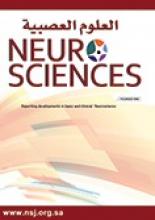Abstract
OBJECTIVE: Dyslexia is a specific language-based disorder of constitutional origin, characterized by difficulties in phonological processing. The Arabic language differs in many aspects from foreign languages and the few previously designed Arabic tests for assessment of dyslexia did not pay attention to phonological awareness problems. This necessitates the design of an Arabic test which could properly assign specific difficulties among Arabic reading dyslexic children, including phonological awareness as a major contributing factor for dyslexia.
METHODS: The study was carried out in Assiut City, Egypt, during the period from September 1999 to the end of January 2001. The newly designed Arabic Reading Test (ART) in this work passed through many stages. Firstly, test construction by 11 Arabic teachers (specific judges). Secondly it was applied, in a pilot study, to 50 normal students (9-10 years old) to ascertain clarity of the test. Then test standardization was proven through application on a second sample (n=252 students), and third sample (n=58 dyslexics).
RESULTS: The reliability of the ART was proven by the test-retest method (r=0.913, p<0.01). Validity was proven by judgment validity, internal consistency validity (ranged from 0.238 for auditory perception to 0.940 for phonological awareness and spelling), contrasted group validity, and criterion related validity (in relation to Schonell r=0.859, Awaad reading r=0.817, Awaad comprehension r=671, mid-term Arabic scores r=0.686).
CONCLUSION: The ART was thus proven to be highly reliable, and valid for assessment of dyslexia among Arabic reading children. It has great value in predicting dyslexia even among preschool age Arabic speaking children, through assessment of their phonological awareness skills, and thus, remediation programs can be properly and early directed.
- Copyright: © Neurosciences
Neurosciences is an Open Access journal and articles published are distributed under the terms of the Creative Commons Attribution-NonCommercial License (CC BY-NC). Readers may copy, distribute, and display the work for non-commercial purposes with the proper citation of the original work.






